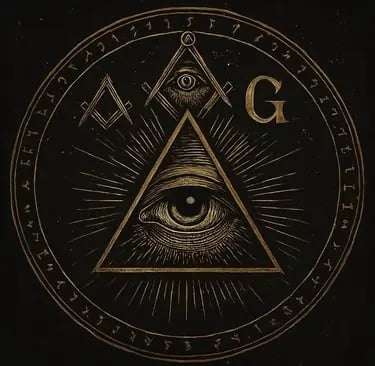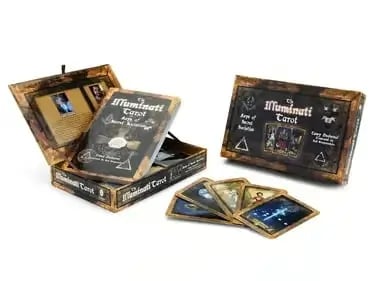Occult Gnosis and the Hidden Teachings
Uncover occult gnosis and the hidden teachings of the Illuminati and Freemasons—Discover ritual methods, dreamwork and exercises to spark experiential gnosis.
OCCULT GNOSIS
Marcel Helmar
10/1/20258 min read


The all‑seeing eye and Masonic symbols — gateways to occult gnosis.
Occult Gnosis and the hidden teachings of the Illuminati and Freemasons have long been whispered about in shadows — not as idle conspiracy, but as fragments of a deeper current of forbidden wisdom. From the veiled rituals of secret societies to the cryptic echoes of the Dead Sea Scrolls and the Golden Dawn, seekers have pursued gnosis not as knowledge written in books, but as revelation carved into the soul. To walk this path is to step beyond doctrine and into the fire of direct experience, where symbols ignite and the unseen world speaks back.
What Is Occult Gnosis?
To speak of gnosis is to speak of a fire that cannot be taught, only caught. Knowledge is the ink on the page, the lecture in the hall, the ritual written down in careful steps. Gnosis is what happens when the veil parts and the symbols stop being symbols — when they burn alive inside you. It is the difference between reading of a candle’s flame and feeling its heat sear your skin.
Gnosis vs. Knowledge
Knowledge is safe. It can be catalogued, debated, and forgotten. Gnosis is dangerous. It arrives unbidden, often in the silence after ritual or in the fever of trance, and it leaves you changed. Where knowledge informs, gnosis transforms.
The Role of Direct Revelation in Esoteric Traditions
Every current of the occult has wrestled with this divide. The Freemason’s search for “light,” the Illuminati’s whispered doctrines, the Golden Dawn’s elaborate initiations — all are scaffolds built to provoke gnosis, not replace it. Even the fragments of the Dead Sea Scrolls hint at a knowing that bypasses priest and temple, a revelation that strikes the seeker directly. To walk this path is to risk madness, but also to taste the raw marrow of the hidden world.
As we peel back the layers of ritual and symbol, it becomes clear that secret societies have always hidden their wisdom in plain sight — encoded in geometry, allegory, and archetype. To glimpse that current is to step into a language of images, where every emblem is a key and every card a doorway.
Illuminati Tarot — Keys of Secret Societies


Unlock the hidden teachings of the Illuminati and Freemasons through this richly illustrated tarot deck. Each card reveals symbols of power, secrecy, and gnosis.
The Illuminati and the Pursuit of Hidden Wisdom
The very name Illuminati drips with both dread and allure. To the fearful, it is a cabal of shadow‑masters pulling the strings of history. To the seeker, it is a whisper of light hidden behind the veil, a promise that gnosis has always been guarded by those who dare to wield it. Whether myth or memory, the Illuminati remain a symbol of forbidden wisdom — knowledge that does not simply inform, but transforms.
Origins and Myths of the Bavarian Illuminati
In 1776, Adam Weishaupt’s Bavarian Illuminati emerged not as demons in cloaks, but as scholars and freethinkers, hungry to tear down the chains of superstition and tyranny. Yet history quickly blurred into legend. Were they merely Enlightenment radicals, or initiates of a deeper current, cloaking their gnosis in the language of reason? The myths grew like ivy: secret lodges, hidden rites, a brotherhood of light that sought to reorder the world. Whether they truly held the keys to ancient mysteries or simply borrowed the trappings of secrecy, the Illuminati became a vessel for every fear and fascination about hidden power.
Gnosis as a Tool of Enlightenment or Control?
Here lies the paradox: gnosis liberates, but it also binds. To glimpse the hidden fire is to awaken, but who decides how that fire is used? The Illuminati, in myth and rumor, embody this tension. Was their pursuit of hidden wisdom meant to free humanity from ignorance, or to forge a new hierarchy where only the initiated could rule? Gnosis can be a lantern in the dark — or a chain of light, dazzling the eyes while binding the will. In the end, the question lingers like smoke after ritual: is hidden knowledge a gift, or a weapon?
Freemasonry and the Mystical Path
The Freemasons have long been painted as architects of hidden empires, but beneath the conspiracy lies a deeper current: a brotherhood obsessed with light, geometry, and the shaping of the soul. Their lodges were not just halls of secrecy, but temples where stone and symbol fused into a living language. To walk the Masonic path was to be initiated into a craft that claimed to build not only cathedrals of stone, but cathedrals of spirit.
The Symbolism of Light and Architecture
Every square, compass, and pillar was more than a tool — it was a glyph of transformation. The Mason’s light was not the sun’s glow, but the illumination of gnosis, a fire hidden in the geometry of creation. Their architecture was a ritual in stone, each angle and arch a reminder that the world itself is a temple, and the initiate its builder.
Freemasonry’s Influence on Occult Traditions
From the Rosicrucians to the Golden Dawn, echoes of Masonic ritual ripple outward. The oaths, the veils, the initiatory climb through degrees — all became scaffolding for later esoteric orders. Whether one sees them as guardians of wisdom or gatekeepers of power, the Masons carried forward the same paradox as the Illuminati: gnosis as both liberation and control..


Occult Illuminati Unisex T‑Shirt
Wear the rite: a hand‑distressed sigil, coiling vertebral geometry, and weathered inks—made to age like a relic.
Occult Gnosis Across Secret Societies
Ritual knowledge travels like a rumor: distorted, ritualized, and treasured by small circles. Across lodges, grimoires, and hidden archives the same aim recurs — to condense cosmology into practice, to make theory wearable. This section traces three threads where gnosis surfaces as choreography, symbol, and heirloom rather than as tidy doctrine.
Golden Dawn and Ritual Gnosis
The Golden Dawn treated ceremony as a laboratory: gestures, words, and props tuned to alter perception and produce inner knowledge. Their emphasis on symbolic correspondences and staged ascent turned abstract esoterica into repeatable procedure. That lineage feeds modern ritual aesthetics: layered sigils, staged lighting, and sequenced gestures that read as both performance and private instruction.
Dead Sea Scrolls and Early Gnostic Currents
Early Gnostic impulses prized revelation over orthodoxy, privileging hidden revelations and interpretive keys to scripture. Texts that circulated in secret offered mythic maps for inner trajectories rather than dogmatic systems, privileging experience over propositional truth. Those currents inform a certain occult taste for fragmentary texts, marginalia, and artifacts that feel like a lost instruction manual folded into plain sight.
New World Order Narratives and Hidden Masters
Modern conspiratorial frameworks graft older ritual vocabularies onto contemporary fears, producing a hybrid language of secret masters, invisible hierarchies, and encoded power. Whether earnest, ironic, or performative, these narratives recycle the idea that knowledge is concentrated and that access confers agency. The useful strand for makers is not the politics but the aesthetics: layered hierarchies of symbols, lineage claims, and the drama of initiation that translate cleanly into merch, zines, and ritualized drops.
How to Seek Gnosis in Modern Practice
Gnosis isn't a destination; it's a practice you fold into the margins of your day. Treat methods as instruments, not dogma — build small, repeatable rituals that shift attention, sharpen perception, and leave a trace on your body and objects. The goal is not spectacle but a palpable rearrangement of inner furniture: new habits, new thresholds, a language you can feel.
Ritual Immersion and Trance
Design rituals that privilege repeatability and sensory focus. Use staged lighting, a single potent object, and a sequence of gestures that cue altered attention; repetition coaxes the mind out of habit and toward threshold states. Keep durations manageable — short, intense practices win over marathon ceremonies — and let physical anchors (breath, posture, a worn talisman) do the heavy lifting when words fail.
Dreamwork and Symbolic Downloads
Treat dreams as field notes and nightly proof of inner weather. Keep a notebook by the bed and collect symbols without over‑decoding them; patterns reveal themselves through accumulation. Use waking exercises — focused imagery, oneiric incubation with a sigil, or a sewn intention before sleep — to invite images that arrive raw and useful rather than explained.
Grounding and Integration
Gnosis needs translation into life or it fragments into aestheticism. After trance or dreamwork, do one concrete thing: sketch a fragment, affix a sigil to a mundane object, or speak the image aloud into a recorder. Anchor insights through daily touchpoints — a shirt you wear, a page you read, a candle you light — so revelation becomes habit and knowledge becomes a lived craft.


A compact, hand‑distressed tarot deck built for bedside divination and ritual integration. Bold imagery reads fast, wears in like a relic, and turns a single card into a daily trigger for insight.
Illuminati Tarot Deck
FAQs on Occult Gnosis and Secret Societies
Is gnosis the same as intuition?
No. Intuition is a quick, often pre‑verbal sense that nudges you toward a decision; gnosis is an excavated knowing built through practice. Intuition sparks, gnosis accumulates. Gnosis has method, ritual, and a traceable lineage—you can point to the exercises, texts, or repeated experiences that produced it—whereas intuition can arrive unbidden and disappear just as fast. Treat intuition as a signal and gnosis as the instrument you build to amplify, test, and translate that signal into insight.
Can beginners access gnosis?
Yes. Gnosis is a craft, not an inherited credential. Start small: brief, repeatable exercises that reliably shift attention, a single talisman you handle daily, nightly dream notes, or a one‑card tarot draw kept to a single question. Consistency matters more than spectacle—ten minutes of focused practice repeated over weeks yields clearer results than one dramatic ritual. Beginners should favor discipline over drama and curiosity over certainty.
How do I know it’s not just imagination?
Because imagination and gnosis leave different traces. Imagination invents freely; gnosis changes behavior, perception, and material practice in repeatable ways. Test experiences against simple criteria: does the insight recur across sessions, does it produce usable changes in your work or rituals, can you externalize it in an artifact that others recognize as meaningful? When a symbol or image consistently returns, prompts useful action, or survives translation into object and language, you’re moving past mere fancy toward a living, practical knowledge.
Conclusion
The Fire Behind the Flame
Gnosis is less a prize than a slow-burning habit: a handful of repeated gestures, a held image, a midnight note that changes how you move through the day. The work isn’t flashy revelation but the steady accretion of attention until ordinary objects and actions carry a charged meaning. Keep the rituals small, the marks tangible, and the practice stubborn; over time those habits become an infrastructure for sight. Tend the flame with discipline and curiosity, and the light it casts will outlast any headline or rumor.
Wear the work: this shirt turns the essay’s quiet practices into a daily talisman—hand‑distressed sigils, coiling vertebral geometry, and weathered inks that read like a found relic. Fold ritual into your routine by wearing a piece that ages with use, anchors dreamwork, and keeps the lessons of gnosis close to the body.


Occult Illuminati Relic Tee
A hand‑distressed ritual sigil tee that wears in like a found relic — unisex, collector‑grade, built to anchor dreamwork and daily practice.
Join Us
Join the Coven: a small, ritual-minded newsletter that arrives like a folded note—short, strange, and useful. Subscribe and get an immediate 10% off code for your first purchase, plus access to early drops, behind-the-scenes ritual notes, and curated occult finds.
About the Author:
Marcel Helmar is a cinematic occult artist, writer, and founder of Horror & Hexes. His work blends ritual symbolism, folk horror, and studio‑grade printmaking to produce limited art drops, immersive essays, and practical ritual guides. Marcel’s writing and visual practice have been used by filmmakers, podcasters, and indie publishers to create atmosphere and authenticity; he teaches workshops on image making, lore research, and publishing for dark‑culture creators. Visitors can browse his gallery, read deep‑dive essays, or join the mailing list for exclusive drops and process notes.
Related Articles
Connect
Explore dark tales and ritualistic mysteries here.
Support
+1-337-718-0155
© 2025. All rights reserved.
Flesh Catechism T-Shirt
Eat Your Heart Out
$22.50

